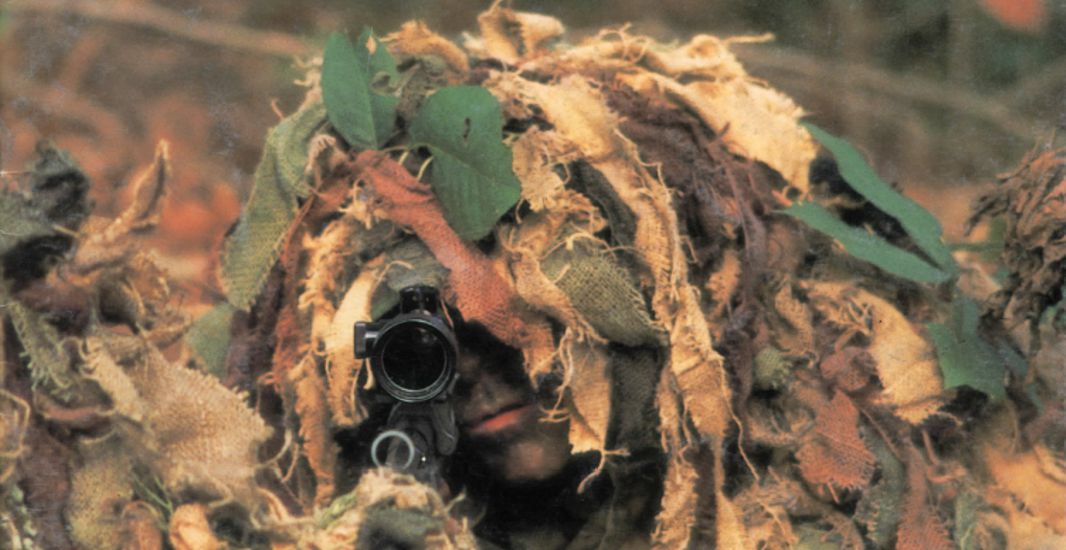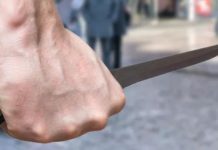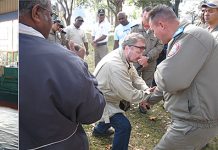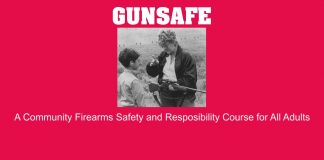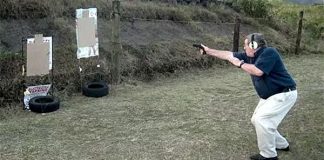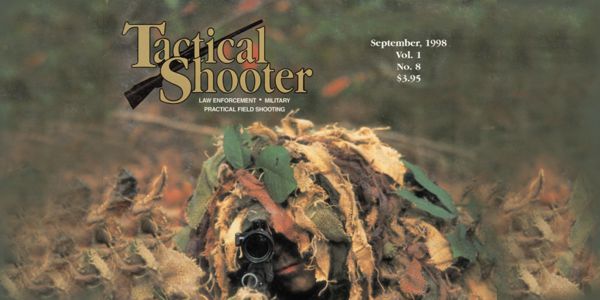 This is the final chapter dealing with the evaluation of L.O.D. Training Associates: a total sniper, equipment, and training system, developed by Mr. Billy Martin, President and his daughter, Billye Jo Martin, Operations Manager. It is with appreciation to those persons mentioned herein that I end with a story about three days in the desert… and about a profession that places dire consequences upon men, young and old, to place accurate rifle fire on demand, under stress.
This is the final chapter dealing with the evaluation of L.O.D. Training Associates: a total sniper, equipment, and training system, developed by Mr. Billy Martin, President and his daughter, Billye Jo Martin, Operations Manager. It is with appreciation to those persons mentioned herein that I end with a story about three days in the desert… and about a profession that places dire consequences upon men, young and old, to place accurate rifle fire on demand, under stress.
In Parts 1 and 2 of this disquisition I had established the exceptional capability of Martin’s rifles. Now I was on my way to evaluate the capability of his rifle in the hands of a sniper team and his ability to help mold them into a professional life-saving system.
Lost In The Desert
I tried to imagine what the next few days would bring as I made my way east out of Las Cruces. New Mexico and toward the small mountain range that separates the city from White Sands Missile Range. I cruised across 5719 feet of the San Augustin Pass transfixed by the expanse of the Chihuahuan Desert dotted with the defining lechuguilla plants, shimmering white radar domes, stunted mesquite brush, transplanted oryx antelope, and the Jarilla Mountains in the distance.
A paisano bird, made famous by the “Road Runner” cartoons, zipped in front of me, making me smile as my eyes searched for the indomitable coyote I knew would be planning the bird’s demise.
My wife and I had driven from Utah the day before, breaking out of a snow storm with temperatures of 23 degrees, and winds of twenty and thirty miles an hour just north of the Arizona border. I wondered what the storm had brought to the desert and to the snipers that had been training at White Sands for the past several days.
The military base is tucked up against the mountains, and I missed the turn on the first pass. After nervously answering the gate guard’s questions, I was directed to the base security building. I waited only minutes for Billy Martin to arrive and escort me to where he was working with several students… just behind the security building as it turned out.
“Come on,” he urged, “The guys are working on their ghillie suits.”
After introductions and an awkward inquiry into the location of the nearest bathroom, I settled into three days of what I can only describe as a walk back in time. Military came, staccato sentences punctuated by “Yes Sir”, and the smell of gun solvent wafting from the several bipod mounted rifles hit old, little-used synapses in my brain.
“What’s the drill?” I asked Martin, trying to act as though I might know what I was talking about. He briefed me on what the students had covered to date and what he expected for the next few days. I had entered the world of sniper academia in mid-stride. I watched the students fash-ioning ghillie suits, took some pictures, and bantered with an ex-Navy SEAL and a Special Forces Sergeant about people and places we had in common: the SF dog lab at Fort Bragg in particular, which we had all attended as it turned out. The compound they described, however, is a far cry from when I had spent a confused month there some 30 years prior.

Billy Martin: Passion, Energy, and Expertise
Martin is an energetic taskmaster, bouncing from student to student and from exercise to exercise. 1 watched in some amount of fascination before turn-ing my attention to the manual that he gives each student. I recognized the loose leaf that was lying before each student’s chair in the classroom. Martin had left a copy with me during his first visit, and I had spent time with it over the months that I was evaluating his rifles. Martin’s general course is comprised of several levels; the manual in my possession, and the one on the student’s desk comprised Levels I, II, and III. Those courses take 12 days (210 hours) to complete. The course and the manual take the students through all the basic, technical aspects of the job: mental preparation and stress management (two subjects on which Martin places particular significance), optics, rifle and equipment care, night vision, understanding mil dots, and about two hundred other subjects needed by the professional. The manual is thorough yet succinct, prepared in a way that lends itself to easy retention.
Martin is also a change-up artist, not allowing the students to settle into patterns. He is constantly placing them under stress, hardship, and changing conditions. About the time I would begin to understand the exercise, and begin thinking how I would approach it for best results, Martin would be off on another variation. leaving me in a bit of an emotional state of mind. anxious for closure. But I saw the value in it as the students went from stationary to moving fire, then to varying ranges. etc. Even I became confused when given a number, the number was called. and an upside-down letter on a target had to be identified among many and then fired on quickly. And l was only taking pictures!
A typical day during Level HI goes something like this: In the classroom by 0800 hours for lectures and tests on calculating hold for slant, wind, and dis-tance: to the range for cold barrel zero. followed by various shooting exercises: back to the classroom to finish ghillie suits, then into the brush for stalking exercises. crawling on one’s stomach for several hundred yards to make the shot: more classroom, then back to the hooch to clean the rifle and prepare for possible call out (or sleep if you are lucky). By the way, I’m still only taking pictures during all of this, thank God. Rap on a team’s door at 1130 hours, then to the classroom for briefing; realistic situation exercise and night shot, taking out the bad guy by 1230 hours: in bed at 0130. The camera and I finally get some shuteye!
The Team Shot
Before we proceed, let me introduce you to the cast:
Billy Martin: President, L.O.D. Mike, Brian. and Tim: Assistant Instructors, L.O.D., Kenneth Zacharias and Clayton Williams: Waco Police Department SWAT Tom Benavidez, Mike Salina, Anthony Martinez: DOD Law Enforcement Officer Rodriguez (teamed with Anthony Martinez): El Paso Police Department Scott Holloway: Navy SEAL Jay Stanka: Special Forces (teamed with Scott Holloway)
Others had started the class but withdrawn because they were not prepared for the hardships of the course. Two started home the morning of the second day of my stay. I later asked the remaining students what kind of shape they were in. They ranged from good to very good to Michael Jordan great, I asked also if they believed a sniper should be in good shape, with good endurance and strength to do their job. The answer was a resounding yes! This seemed to justify itself, since those remaining were still game, enthusiastic, and hard core… though the long. hard pull of the drag hag on their bellies had not yet begun.
I remembered back to my assignment on this gig: Stick to the accuracy capability issues, nix the protocol. But as I watched the teams go through their drills, I came to realize that accuracy for them was much more than just the possession of an accurate rifle and ammunition. It involved mental and physical toughness, the ability to take the shot under duress, understanding how to deal with the situation, a thorough grasp of the technical issues of ballistics/dealing with wind, distance, slant, and a myriad of other details, and finally, fighting the emotional roller coaster a political administration often places on those on the front line. if these could not be successfully dealt with, shot placement could be anybody’s guess.

Trust is essential. The fire control center. the brain of the operation. is the team spotter… the man on the gun, the mechanic. Both must trust the other to do his job correctly. The spotter calls the come-up, wind hold-off, and any other necessary information, and the man on the gun, right or wrong, executes. He must believe the spotter’s call. The spotter must trust his information and the gunner’s immediate response to his call. Without immediate response the moment is lost and the shot missed. Changing conditions are too rapid for hesitation.
I listened intently to Clayton Williams as he studied the image through the Leupold spotting scope. “up 2, right r and the immediate report that followed. The shot from Kenneth Zacharias’ rifle struck dead center, Mike walked over to me at that moment and whispered. “You’re watching two outstanding professionals”.
I had been watching them with increasing interest since I had arrived. They took this stuff seriously. They were the example of the marriage of capable rifles and humans that can produce what is possible in a modern sniper system.
“These guys always have their equipment ready.” he continued. “They are quick to respond, and have a great mental attitude with good intentions. They anticipate the exercises, and their performance is high. They’re cool professionals.”
I had to agree. All the teams that fin-ished were serious about the course and turned in good, acceptable performances. The Waco Team had the advantage. however. having taken Level I of the course some months before. But it was not difficult to see that they had done their homework as well. I began to marvel at their ability to take the shot, on demand, accurately, under any condition asked of them.
Scott Holloway (SEAL) and Jay Stanka (Special Forces) had never worked together, nor was their job that of profes-sional snipers. For them, this course was one among many that they would take to be all around soldiers. Jimmy Rodriguez and Tony Martinez had never teamed together, either. The other DOD personnel, Tom Benavidez and Mike Sahno, are law enforcement instructors at the base. Their job would be that of WSMR’s 1st Civil-ian DOD Team.
Taking this into consideration, the team I decided to concentrate on for this exposé was the Waco Team. This was their game, their world. They seemed as much a part and complement of each other as bread and butter. While each of the gentlemen who attended this course was serious about what he was doing, and while each was an effective rifleman, I wanted a team who had entered the course as a team, would leave as a team, and remain a team whose primary job it would be to save lives together. I had established the effectiveness of Martin’s rifle to my satisfaction; now I wanted to watch a professional team drive it. and to watch what capabilities could be confirmed off the bench in the field. And. of course, they were shooting the L.O.D. rifle.
Martin’s rifle and the Waco Team to drive it was the symbiosis. the marriage of accurate rifle and trained, dedicated humans that 1 wanted to see. what I had come to understand in the phrase: The Accuracy Expectations Of A Modern Sniper … One Shot, On Demand. Under Stress.
Which leads me to paraphrase a bit of philosophy before we take account of what is possible…
Conversations With Billy Martin
On the second night of my stay; I had the opportunity to play the investigative reporter with Martin. We drove to Las Cruces to pick up supplies and have dinner. Without resorting to the drudgery of a written question and answer exposé, let me provide a few of Martin’s answers from which I believe you can infer the questions.
Level Of Performance: The rifle should be capable of 1/5 MOA or better. The student team should be able to produce I15 to 1 MOA under normal circumstances, and 2 MOA under stress. The competent “Overwatch Protection Member” should be capable of less than 1 MOA under any conditions. The aforementioned standards hold true out to a minimum of 300 yards. A tall order indeed.
Design And Weight Of The Rifle: The rifle is ergonomically designed. Functionality requirements dictate the weight. The design reduces recoil and lends itself to linear movement. The weight and shape helps the operator assume a natural point of aim and enhances performance. The several innovative details built into tip of the nose is a center hit. The arrow the rifle ensures more rounds at an acceptable level of performance.
Mental Preparation: This is a bit more complex than it sounds. It should be obvious that superior control and men-tal attitude are prerequisite to making a first shot incapacitation, on demand, under stress. This is, again, more difficult than it sounds considering the consequences. But sniping is a team effort, and not only does each member have to possess outstanding mental preparation. but they must do so in tandem… as a unit: spotter and shooter.
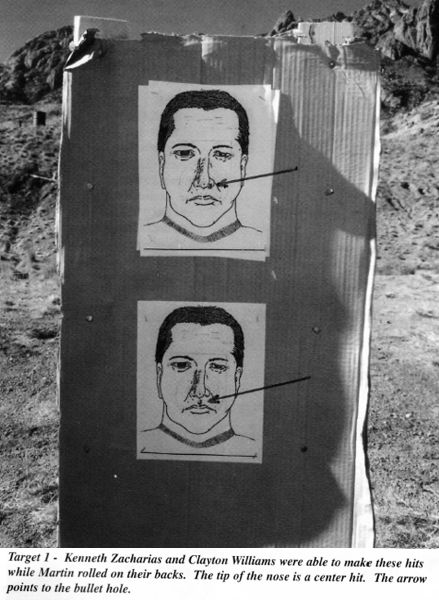 Technical and Legal Issues: To the layman the job of a sniper sounds simplistic: find the target and pull the trigger. The truth is that the competent sniper must combine experience with a considerable amount of knowledge and under standing of ballistics, basic trigonometry, equipment. etc. He must be able to quickly assess intense situations and act with prudence and impunity. This is far from an easy task when they are closely monitored and governed by legal issues, and their performance in any situation will be investigated in detail. The sniper who is not competent in all of this should not be a sniper. It takes a special person to pull the trigger responsibly as well as accurately. No sir, it is neither easy nor simple.
Technical and Legal Issues: To the layman the job of a sniper sounds simplistic: find the target and pull the trigger. The truth is that the competent sniper must combine experience with a considerable amount of knowledge and under standing of ballistics, basic trigonometry, equipment. etc. He must be able to quickly assess intense situations and act with prudence and impunity. This is far from an easy task when they are closely monitored and governed by legal issues, and their performance in any situation will be investigated in detail. The sniper who is not competent in all of this should not be a sniper. It takes a special person to pull the trigger responsibly as well as accurately. No sir, it is neither easy nor simple.
Cold Barrel Shots and Field Shooting Exercises
Martin had the students fire cold barrel shots at some point in each day’s activities. These were taken under vary-ing distances and conditions. Shortly after this Martin would begin changing the menu: KIM exercises, moving tar-gets, various positions…. Though some were seemingly peculiar to such a novice as I, all were effective. I was amazed at the ability of the students to perform under these strange situations. For exam-ple, at one point Martin laid down on top of the snipers and began to roll, grab their clothing, and pick up their feet. After some seconds of doing this, he ordered them to take the shot. However, he didn’t stop rolling and grabbing. All shots by all students were killing shots. Those taken by the Waco team grazed the tiny ten ring.
Another exercise had the students fire a ten-round group starting with a cold. clean barrel. Martin instructed the stu-dents to fire as soon as the reticle quartered the target with the proper hold-off in mils. The wind speed was measured at 27 mph and gusting. Waco Team member Zacharias’ target is shown. The small amount of weather report in the group was to be expected.
A third exercise, one theft me a little awestruck at the students’ ability to handle it, intimidated the hell out of me. It went like this: Martin wrote letters on each target. These were sometimes upside down, reversed, at various positions on the target, etc. Each student was then given a number and a letter. Martin did this with clarity but did not belabor the point. After some minutes of setting up the targets and making everything ready, he called a number. The man who had been designated by that number was expected to approach the line and get in position. It took a couple of seconds for the student to remember what Martin had said. Was he that number? When in position, Martin told the shooter to identify his target and take it. That may not sound too difficult except that there were fifteen targets posted, only one having his letter … which might be upside down or sideways or repeated on the target or … and the shooter had only seconds to make the shot. Most were killing shots, but here again, the WACO team hit dead nuts. I wondered if I could have identified my target among so many posted, brought the rifle into position, and placed the shot at the point of intent so quickly. No way.
The most intriguing and interesting exercise was the night shot. At 1130 hours Martin’s instructors would call out one of the sniper teams. The team was taken to command headquarters and briefed. The situation was described in detail to the team. Location/most likely hide, approximate distance, target identification, situation. and site command location were given to the team. The team was advised that when they were in position and had identified the target, command would begin a 5-second countdown. On the count of three, powerful lights would be turned on and directed at the target. By the count of 1 the shot must be taken.
After listening to the briefing, I joined command at the site, waiting for the snipers to crawl into the hide approximately 150 yards from the Target Prom’ rubber mannequin which stood on a 55 gallon drum for support. The mannequin wore a camo shirt and beret with a metal pendent, and was faced approximately 45 degrees to the right of the proposed hide. This information had been given to the snipers. Though only an exercise, I could feel the tension in the air… an atmosphere of realism and excitement.
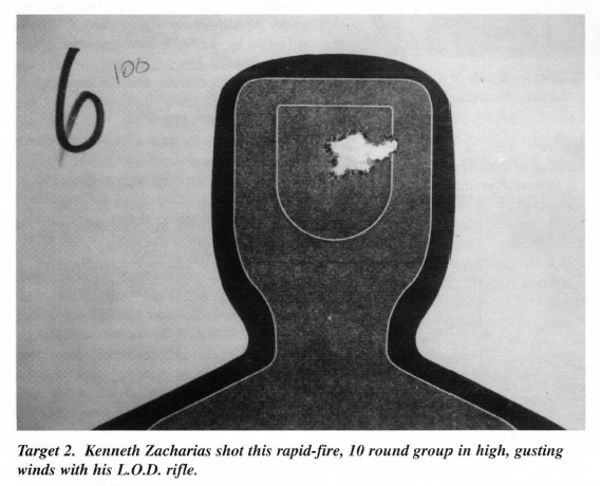 The team had a set of AN-PVS 7Bs from Excalibur with a 5x magnifier attached to allow them to make positive target identification by the observer. The sniper had only a Leupold Mark 4-M1 affixed to his L.O.D. rifle.
The team had a set of AN-PVS 7Bs from Excalibur with a 5x magnifier attached to allow them to make positive target identification by the observer. The sniper had only a Leupold Mark 4-M1 affixed to his L.O.D. rifle.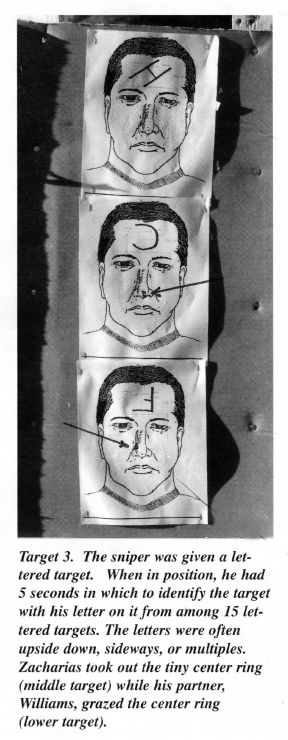
With some difficulty in the darkness, I had my camera trained on the target. The sniper’s position. the command position, and the target formed the three points of a triangle. While we and the snipers were approximately 150 yards from the target. the team and command (where I stood) were only about 50 yards apart. I knew the sniper’s approach and the moments in which they were advancing, yet I could not pick them out nor did I ever hear them.
When I heard the countdown begin, I moved to the camera. At the count of three, the lights came on and I hit the but-ton on the camera that would allow enough time for the shutter to gather adequate light, approximately 3/4 of a second. I heard the shot before the camera shutter closed… the lights went out.
An eerie silence followed. I don’t know why. Maybe in each man’s heart and mind, the realism of the situation left them momentarily shocked, wondering, expectant… did the Waco Team make the hit or not?
Then just as suddenly all the lights came on: the powerful hand-held light and those from the three vehicles at the command location, all were trained on the target. We all walked toward the rubber man: amazingly realistic, stoic on his oil drum, still staring toward the mountain range to the west. At about 5 yards I could see the tiniest, black spot on the mannequin’s cheek. It was the entrance hole of the bullet. Being rubber. the material expanded to let the bullet through and then closed to a small hole 1.5 inches forward of the ear and 1.5 inches above the jaw line. Unknown to me at the time, Martin had affixed OD tape to the back of the mannequin’s neck. The bullet had exited through that tape, indicating a hit of the medulla oblongata.
As I took pictures and listened to the debriefing, bathed in the light from the vehicles, I thought about what I had just witnessed. The marriage of rifle, spotter, and shooter had once again accomplished what I had come to see: The Accuracy Capabilities Of A Modern Sniper … One Shot, On Demand. Under Stress. Damn, I was impressed! All I could think of that seemed to have any coherent intelligence and truth was: I hope nobody ever sends these guys after me.
The same exercise was run the following night. It was the Green Beret/SEAL Team’s night in the barrel. But as we walked to the target this time, the most astonishing thing began to appear as we got closer to the target. Yes, there appeared to be another tiny hole, identical to the first approximately a quarter inch from the one put there the previous night. Holloway’s bullet had almost hit Zacharias’. And it had torn a hole in the tape a similar distance from his in the back of the mannequin’s neck. If you didn’t get that, let me summarize: two different teams on different nights had each placed their bullet perfectly on the target and taken the medulla oblongata. They had done so in no more than one second after the target was illuminated. They had also done so after a minimum time in the hide after crawling in the dark approximately 200 yards with a drag. Astonishing!
Nor did it escape me that Stanka, Holloway. Williams, and Zacharias all used L.O.D. rifles.
I remembered Martin’s instruction during the briefing: quarter the target (I knew he meant the head). Don’t include the beret. Simple enough, but how did they assess the target and take the shot in such a short amount of time? 1 asked Holloway.

“Looking through the Leupold scope I could see the target very dimly in the dark. I could see the oil barrel and make out that there was something above it. I put the crosshairs near the top of the dark object above the barrel and told them I was ready. We had estimated the distance at 150 yards. When the lights came on, I had only inches to move the crosshairs. I quartered the target and took the shot. The rifle is so steady in the prone position that it was easy to do with-out disturbing my aiming point.”
I remembered the Waco team’s answer when I had asked a similar question about how they had hit center when Martin was rolling on their backs.
I got Martin’s rhythm. After he told me to take the shot, I waited for the opportunity I knew was coming.”
To me this added a new dimension: the shooter who thinks. The shooter can’t always be the non-thinking mechanic, doing bid immediately and only as the spotter commands. He can’t only think about form, sight picture, and weapon function like an automaton. He, at times, must be the one to make the decisions:
when, how, where, while the spotter can only look on with as much faith and concern as the rest of us.
The Long Haul
When I arrived at the small building Martin was using for training on the second morning of my stay, I was informed that the students would be doing stalking exercises right after cold barrel exercises. I had some inkling of what this meant from previous discussions with Martin and was anxious to get on with it.


After the snipers had decked themselves out in previously self made ghillie suits, we all proceeded to a location a mile or so to the north of the training building. The area was sparsely covered with mesquite brush, huisache, cactus, lechuguilla and tufts of a medium height. yellow grass that was going to seed. Shallow gullies and depressions crossed the area the snipers would have to negotiate to put a shot into Martin who would man the glass, trying to spot the snipers before they could take him out. I had the snipers line up against Martin’s truck before they proceeded on to the starting point some 700 yards away where a wash had carved a deeper slice in the earth’s surface.
I took up a position about 200 yards closer to the starting line than where Martin and another of his instructors stood in the bed of a pickup waiting. I lost patience quickly and rationalized that should be taking pictures of them crawl-ing in their camo. I walked quickly to the starting line and got there just aS they were beginning their long crawl. I really got into this. especially since I only had a camera and could prance around the area standing erect. The snipers, on the other hand, continued to crawl flat on their bellies, pulling the rifle and other sundry gear along with them.
This was a great teaching and learning exercise, even for the likes of me. After two days, and 3 such crawls, we all were getting better at taking Mr. Martin from his perch in the pickup: me with my camera. and the snipers with their rifles.
Conclusions
While I think of myself as a reasonably accomplished field shooter, reloader, hunter, and rifle competitor, I am not a sniper. I have tried very hard during the writing of this series of articles to understand the sniper’s job, his capabilities, and his problems, and to report accurately and honestly about what I tested and experienced. I sincerely hope that the reader believes that this outsider’s efforts were worthy, and that I have accomplished what was asked of me.
I started writing for Mr. Brennan, the editor of both Precision Shooting and Tactical Shooter, in or about 1986. I remember with great clarity his advice after he flatly refused to print one of my first articles into which I had dripped a bit of my life’s blood:
“There have got to be conclusions,” … and, “Twelve good men and true couldn’t understand a damn thing you wrote.” And so here you are, Mr. Brennan:
My mission was to dog the principle of L.O.D. Training Associates as long as it took to evaluate the capability of his rifles and the ability of his trained snipers to deliver accurate rifle fire. With some definition of just what that meant, I found the following to be true.
1. The Tactical Precision Marksman Rifle produced and sold by L.O.D. is an excellent rifle, offering the shooter extremely good accuracy for a rifle of its type. It is well designed and thought out, using ergonomics for comfort and for function, modern coatings, the best in materials, and the best craftsmen. It is a quality instrument at an affordable price. This was born out by exhaustive testing (see parts I and 2 of this series of articles). In short, the rifle has substantially bet-ter capability than the 1/2 MOA advertised.
2. Mr. Martin’s training materials are thorough, succinct, and understand-able. He includes a manual, a data book, and several valuable shooting aids in his course. I listened to 3 days of lectures and found them to be professional, passionate. well-designed for the job the students are faced with, and extremely informative about not only shooting skills but mental. physical. and legal issues as well.
3. Martin understands the bond between rifle, spotter. shooter, and equipment. He is sensitive to the requirements and dire consequences of the job. In the short time he had to work with the snipers, he used tactics and exercises that stimulated understanding, thinking, and the importance of teamwork.
4. Tested within the bounds of L.O.D.’s parameters, the snipers were able to deliver acceptable, accurate rifle fire on demand, under stress. L.O.D.’s boundaries included first shot incapacitation from cold, clean barrels, stress. hardship, and considerable situation variation. The best teams were able to deliver within the accuracy level of my testing (see part 2 of this series of articles) even though under much poorer conditions. All shooters were able to perform within or near the boundaries.

And with that I shall leave off watching, interrogating, and hounding poor Mr. Martin, put an end to this series of articles, and get on with … What’s next, Mr. Brennan?
Denouement
I would like to thank Mr. Billy Martin, principal of L.O.D., and his instructors. Brian. Tim. and Mike for their assistance and hospitality. You treated me like I was somebody, and did so with quiet, unassuming patience.
To the students with whom I spent 3 days in the sands of New Mexico, I would like to extend my appreciation for the work you have undertaken. Here is one civilian that has come to know a little better what you must face each day. While I wish that your job and your skills were not needed, I recognize that they are; and I hope it is your team that is called should me or mine have need. I know you will make that first shot an accurate one.
LOD Precision Marksman Sniper Rifle Part 2
LOD Precision Marksman Sniper Rifle Part 1
Article by Jacob Gottfredson in Tactical Shooter, September 1998

